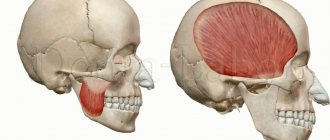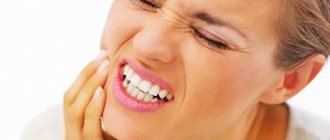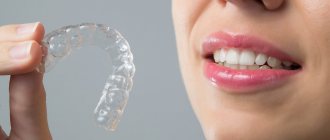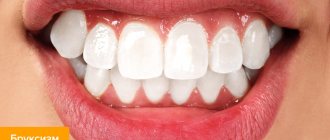Botulinum toxin type A preparations are better known in our country as Botox and are firmly associated with getting rid of early wrinkles. But there are a number of inaccuracies here. Firstly, Botox is not a group of drugs or an active substance, but a trade name for a very specific drug, which, nevertheless, has become a household name, that is, it is used to refer to all similar drugs in general. And secondly, the range of tasks for such tools is much wider!
What are the advantages of botulinum therapy with Botulax in the treatment of bruxism?
- Myorelaxation Complete relaxation of tight masticatory muscles and elimination of painful spasm.
- Long-lasting effect After one procedure, the relaxing effect lasts for several months.
- Quick relief from pain The drug begins to act immediately and gently relieves stress and discomfort.
- Point effect The medicine is administered to strictly defined points and does not affect the functioning of other facial structures.
- Getting rid of a bad habit You will quietly get out of the habit of clenching your jaw and aggravating the consequences of bruxism.
- Maximum safety The drug does not cause addiction and is completely eliminated from the body.
There is a solution for each case!
1 procedure
1 Botulax procedure Gentle and safe effect For mild cases of hypertonicity of the masticatory muscles RUB 15,000. 15,000 rub.
3 procedures
A course of 3 Botulax procedures Gentle and safe effects For moderate and severe stages of hypertonicity RUB 35,000. 35,000 rub.
Botulinum therapy can help if you have a habit of clenching your jaw tightly and grinding your teeth, you suffer from increased abrasion of enamel and destruction of crowns.
Symptoms of hypertonicity of the masticatory muscles and bruxism
- the chewing surfaces of the teeth become worn and flat (the cutting edges disappear),
- tooth enamel chips, wedge-shaped defects appear, fillings fly out, teeth quickly decay, become loose, gums hurt,
- you experience discomfort when opening your mouth, while eating or yawning - there are clicks, crunching sounds,
- you or your loved ones notice that you are grinding your teeth - the characteristic grinding appears mainly at night (the so-called “night bruxism”), when it is difficult for a person to control himself during sleep,
- cramps the jaw - you cannot fully open or close your mouth, the jaw seems to be blocked,
- it is difficult for you to keep your mouth open for a long time, overexertion and pain appear during bruxism,
- when talking or chewing, you feel that your facial muscles are “clogged”, tired,
- when you are angry, tense or just working in concentration - your mouth is tightly closed, your lips are pursed, your teeth are closed, you are literally clenching your jaw,
- there are problems with your bite – your teeth don’t fit together correctly, your jaws are misaligned relative to each other, causing you to bite your cheeks or tongue,
- after concentrated work or under stress, you often have a pressing sensation in your temples, pain and dizziness,
- you notice ringing and noise in your ears,
- Over time, the lower half of your face has become visually square, heavy,
- there are problems with posture - you are slouched, your lower back hurts, your neck is stiff, one shoulder is higher than the other.
If you find one or more signs in yourself, then this is a reason to consult a specialist for medical help. And the first step is a comprehensive diagnosis and search for the causes of hypertension.
We approach the treatment of bruxism comprehensively! We carry out in-depth diagnostics, find the exact cause of facial muscle spasm and eliminate it using advanced methods - safely and with high results.
Free consultation
The main causes of bruxism in adults and jaw strain
- psycho-emotional reasons: nervous overstrain, prolonged stress, difficult experiences of situations,
- dental reasons: prolonged absence of teeth, malocclusion, diseases of the temporomandibular joint, complete or almost complete absence of teeth, inconvenient and poorly made crowns and dentures, fillings that are too high, injuries to the dental system,
- disorders of the musculoskeletal system: injuries and curvature of the spine, poor posture, asymmetry in the work of the core muscles,
- neurological causes: epilepsy, birth trauma, brain and central nervous system damage,
- other reasons: taking certain medications, smoking, abuse of caffeine-containing drinks.
“We always take a comprehensive approach to solving problems of hypertonicity of facial muscles. First of all, we look for causes from the maxillofacial apparatus - we carry out a full diagnosis and examination, evaluate the functioning of the masticatory muscles, identify the patient’s characteristic habits and collect a medical history. If necessary, we refer the patient to specialized specialists - a neurologist, psychotherapist, etc. It is very important to cure hypertonicity - at least so that the patient in the future can safely begin high-quality dental restoration: implantation, prosthetics or treatment.”
Aida Vladimirovna Jutova, implant surgeon, periodontist, work experience of more than 10 years make an appointment
How to properly treat trismus of the masticatory muscle?
Treatment of the problem involves:
- immobilization of the jaw by applying a bandage or splint;
- eliminating the underlying cause of trismus (disease or specific condition);
- taking neuropsychic stimulants and sedatives;
- a course of taking muscle relaxants;
- a course of antibiotics (for inflammatory processes);
- physiotherapy;
- peace and release from physical work.
If the patient’s condition is severe, observation in a hospital is necessary under the supervision of a maxillofacial surgeon, neurologist, traumatologist, etc.
After eliminating acute symptoms, a person is recommended a special diet:
- plenty of fluid;
- chopped food;
- vegetables and fruits;
- natural juices.
If it is impossible to eat normally, food is supplied through a tube, and liquid is supplied through the skin.
To restore the functions of the masticatory muscle, the patient is recommended to perform special therapeutic and preventive exercises.
It is important to completely cure trismus, and not just suppress its symptoms. If the cause is not removed, the problem will reoccur. Spasms put a powerful strain on the teeth, gums, and nervous system. It is very important to contact an experienced dentist with a surgical profile, who will help cure the disease and tell you what to do in emergency situations. The 32 Dent network of clinics in Moscow employs specialists who will provide such comprehensive assistance for trismus of the masticatory muscle and other serious problems.
If you have a problem similar to that described in this article, be sure to contact our specialists. Don't diagnose yourself!
Why you should call us now:
- We will answer all your questions in 3 minutes
- Free consultation
- The average work experience of doctors is 12 years
- Convenient location of clinics
Single contact phone number: +7
Make an appointment
Botulinum therapy as one of the methods for treating hypertension and bruxism
Botulinum toxin type A, which is used in medicine and cosmetology, is able to relieve spasms and relax overstrained muscles, specifically reducing their activity or immobilizing them completely. But not forever, but only for a certain period of time - during this time the body adapts to new circumstances and stops overstraining a certain area. That is, the therapeutic effect for a diagnosis such as “bruxism” lasts for a long time, which is confirmed by numerous reviews from patients.
How it works?
Botulinum toxin type A is a neurotoxin produced by the bacteria Clostridium botulinum. It blocks nerve impulses from the central nervous system to muscle fibers. That is, in fact, the drug paralyzes a certain muscle without transmitting motor commands from the brain to it.
In medicine and cosmetology, it is used in ultra-small and highly purified forms - that is, it is not poisonous or toxic to the body!
The drug is injected into clearly defined points in order to affect only a specific muscle and not affect the work of others. The dosages are harmless, and the blocking is reversible. Over time, the drug is completely eliminated from the body - usually this takes from 5 to 7 months. Gradually, neuromuscular conduction in the area is restored, and mobility returns to the muscle - but since it has “rested,” the spasmodic fibers are smoothed out, and the body adapts and normalizes the load.
Botulinum toxin only relieves hypertonicity and allows the muscle to relax. This is the basis of its well-known cosmetic effect - smoothing out wrinkles by blocking the work of facial muscles. That is, it is wrong to think that you can “pump yourself up” with botulinum toxin preparations - they do not in any way increase the volume of soft tissues.
To relieve excess tension in the masticatory muscles, we use the drug Botulax for intramuscular injection with 99% active substance content, thereby increasing the speed of onset and duration of the therapeutic effect. And thanks to the high degree of purification of the drug, the risk of adverse reactions is minimized. The dosage and course are selected by the doctor strictly individually!
Botulinum therapy as a method of treating bruxism
Botulinum therapy is effectively used to relieve overstrain in the masticatory muscles, fights bruxism and can relieve involuntary teeth grinding at night.
In medicine, as in cosmetology, botulinum toxin type A is used. It is able to immobilize a muscle or relieve tension in it, acting locally. This effect lasts only for a certain period of time. But during this time the body manages to get used to the new state, and the overstrain disappears completely.
Botulinum toxin type A is a neurotoxin produced by the bacteria Clostridium botulinum. It is capable of blocking impulses from the central nervous system sent to the muscles. In fact, botulinum toxin paralyzes them, breaking the connection between muscle fibers and the brain.
The drug is injected into the required areas, so it has an effect exclusively on the desired areas. Dosages of butolotoxin are completely safe, and its effect is reversible. After six months, it is completely eliminated from the patient’s tissues.
Indications and contraindications for botulinum therapy of masticatory muscles
Indications
- pain in the temporomandibular joint area,
- limited mouth opening,
- clicking, crunching, discomfort when moving the lower jaw,
- pathological abrasion of enamel,
- overstrain of the masticatory muscles, their soreness and heaviness,
- preparation for implantation, classical prosthetics (especially veneers), orthodontic treatment.
Contraindications
- pustular skin lesions, ulcers, acute infection in the area of the masticatory muscles,
- viral and infectious diseases in the acute stage,
- neuromuscular diseases (myasthenia gravis),
- constant use of certain medications and antibiotics,
- pregnancy and lactation period,
- bleeding disorders,
- diabetes,
- allergic reactions to the components of the drug,
- oncology and severe mental disorders.
Diagnostics
The patient experiences pain from jaw movement. In this situation, it is necessary to consult a doctor as soon as possible to begin treatment. It is necessary to find out how to relieve jaw muscle spasm in order to restore health.
During the examination and history taking, the doctor observes the patient, paying attention to his posture and head tilt, neck movements, facial expressions, and facial expressions. The state of the muscles during speaking and swallowing is determined. The presence of the corneal reflex is checked, and the amplitude of movements of the lower jaw is determined. The doctor finds out whether there are problems with the spine.
The patient is examined using diagnostic equipment, an occlusiogram is prescribed to determine the type of bite, and its dynamics and statics are measured. If necessary, an X-ray of the TMJ and an orthopantomogram of the jaws are prescribed, and an electromyographic study is performed.
Main stages of treatment
Step 1. Preparation for the procedure
A doctor, for example, an implant surgeon or an orthopedist, may refer you to the botulinum therapy procedure for comprehensive preparation before installing implants or dentures. But you can also contact your dentist yourself with complaints about the symptoms of dental bruxism. On the recommendation of a doctor, after consultation and diagnosis, you can begin the injection course.
No complicated preparation is required. 2-3 days before the procedure, it is advisable to eliminate alcohol and reduce the consumption of tea, coffee and energy drinks, as well as stop taking blood thinning medications and antibiotics.
Experienced doctors who follow safety precautions! Our specialists have undergone appropriate training, are certified and accurately calculate the dosage of the drug. We carry out treatment carefully, safely and with results!
Sign up
Step 2. Administration of the drug
The procedure itself takes on average 20 minutes. The doctor conducts a follow-up examination and marks points for drug administration.
The doctor takes the ampoule out of the refrigerator and opens the disposable syringe with the medicine in front of you - this way you will make sure that the storage conditions and sterility of the drug are observed. How many units of Botox are needed for bruxism? The specialist will calculate the dose individually, based on the severity of the symptoms, and divide it into 3-4 parts - that is, you will be given several small injections in different areas of the muscle. For injections, disposable sterile syringes with thin needles are used, so the procedure is almost painless. But for greater comfort, the injection site can be numbed.
Step 3. Rehabilitation period
The drug begins to act immediately, but gains maximum strength gradually - over about 10-14 days, during which the spasmodic area completely relaxes. At this time, it is undesirable to overheat and overcool the problem area: that is, you will have to limit physical activity, trips to the bathhouse and sauna, as well as to the pool.
It is also important in the first days to touch your face as little as possible and not to steam or massage the injection sites.
The effect of the drug lasts up to 7 months, but may weaken faster depending on individual characteristics. Your doctor will tell you at your follow-up appointment whether you need a repeat course.
How to stop facial hyperkinesis. Administration of Botulinum toxin A
Botulinum toxin A (Botox, Dysport) is a means of reducing the excitability of the muscles involved in hyperkinesis. The drug is one of the most convenient options for the symptomatic treatment of spasms of the muscles of the face and eyes, and other hyperkinesis. We inject Botulinum Toxin A using a syringe with a very thin needle directly into the affected muscle, after which the muscle stops engaging in tics or other hyperkinesis. The effect develops within 3-5 days and lasts up to 4-8 months. During this time, a course of treatment of the causes of the disease and rehabilitation procedures (massage, gymnastics, physiotherapy, psychotherapy, cosmetic procedures) are carried out.
Disadvantages of treating bruxism with Botulax
It is important to choose an experienced, certified doctor who has trained and has official approval for botulinum toxin injection therapy - this is a rather complex procedure with its own subtleties. If the rules of storage, selection of dosage and administration technique are not followed, complications may occur. And if hematomas, bruises or slight swelling basically go away on their own, then difficulties with swallowing and chewing should be eliminated together with a doctor.
Our doctors have been trained and certified - treating hypertonicity with botulinum therapy in our clinic is completely safe
Why is botulinum therapy not enough to eliminate hypertension?
You need to understand that Botox treatment in dentistry, like orthopedic treatment of bruxism (that is, the manufacture of special protective mouth guards for teeth during bruxism), is only an additional, and not an independent method. Botulinum therapy protects against the consequences of muscle strain - that is, visible relief will actually occur after administration of the drug. The spasm will go away, the muscles will relax, you will stop involuntarily clenching your jaw and thereby injuring your teeth. But as soon as the effect of botulinum toxin wears off, the problem may return, albeit to a lesser extent.
Of course, if it was just a formed habit based on nervousness, and the causes of bruxism are psychosomatic or neurological, then during treatment you have a good chance to completely get rid of it. But if the source lies in other pathologies and disorders, then you also need to address them: take care of your posture, solve bite problems, restore damaged teeth, replace low-quality dentures, etc. And botulinum therapy will become an effective comprehensive measure.
Treatment of facial muscle spasms
Depending on the detected causes of the disease, your doctor will choose the appropriate combination from a wide range of treatment methods:
- Prescription of drug therapy aimed at reducing irritation of the facial nerve root, restoring blood supply, eliminating infection if it is detected;
- Injection of Botulinum toxin A into muscles subject to involuntary contractions;
- Acupuncture, massage, gymnastics;
- Special neuropsychological gymnastics, which allows you to normalize the relationships between different parts of the brain;
- Carrying out neurosurgical intervention to eliminate contact between the modified vessel and the root of the facial nerve (microvascular decompression) or remove the tumor.
Why are mouthguards needed for bruxism?
Another additional way to treat hypertonicity of the masticatory muscles in adults is to wear a special protective mouth guard (they are also called a “mouth guard” or “bruxism trainer”). These are plastic and dense overlays for teeth, which are worn mainly at night, and in case of severe symptoms, worn during the day. They are made from hypoallergenic materials in a dental laboratory individually for the patient or at the factory, if we are talking about mass production.
But this is also an auxiliary measure - a mouth guard helps muscles relax, protects against tooth wear and the consequences of bruxism, but does not remove the cause of hypertonicity.
- protection of enamel from cracks, chips, increased abrasion due to involuntary clenching of teeth,
- protection of artificial crowns, dentures (including those on implants) or brace systems from damage,
- relieving tension and pain in masticatory muscles and joints,
- protection against movement and displacement of teeth due to constant pressure on them,
- gradual return of the jaws and joints to the correct position in the event of their displacement (of course, only individual mouthguards for bruxism made by a doctor work this way).
Choosing a sleep guard for bruxism: types and price
Firstly, there are universal and individual options: finished products are produced in factories using standard templates, and custom-made mouth guards are made exactly to your measurements.
Also, as we mentioned, mouthguards are not only night guards. The vast majority of patients suffer from teeth grinding during sleep, but a number of people cannot control jaw clenching during the day - for such cases, there are options for daytime overlays that are more invisible and do not affect pronunciation.
A mouthguard for teeth against bruxism, especially a night guard, can be bought at a pharmacy (either in Moscow or in any other city). It costs about two to three times less than a custom-made one. The quality depends on the manufacturer, and universal options have limitations in size and shape, so they simply may not fit the dentition. But the most important limitation, which patients often forget about, is that a ready-made onlay should be purchased on the recommendation of a dentist, and not self-medicated. Alas, without diagnosing and searching for the causes of spasm of the masticatory muscles, a ready-made mouth guard will do more harm than good.
Therefore, it is better if the mouth guard is made individually - based on a cast of your jaws. Individual mouthguards for bruxism, made for sleep, take into account anatomical features to the smallest detail and do not overload the teeth. And if you need to wear the veneer during the day, then it should match the shape of the teeth so that it is truly invisible when communicating. You can order such a mouthguard for bruxism in dentistry by contacting your doctor about this problem.
The doctor will also give recommendations on how long a day it is best to wear a mouth guard, how to care for it, and when the product should be replaced.
Examination for facial hyperkinesis
The success of treatment directly depends on an accurate diagnosis of the location and cause of damage to the pathways and brain centers of the facial nerve. Therefore, we carefully examine each patient. Your doctor will determine the cause of excessive stimulation of the facial muscles, and based on the data obtained, select the most effective treatment.
MRI and X-ray computed tomography of the brain and facial skull. On tomograms, especially if they are performed with preliminary contrast, the brain centers of the facial nerve and its area of exit (root) to the base of the brain, blood vessels, and skull bones are visible. They help to see the cause of compression of the facial nerve root and evaluate the structure of the salivary glands. Circulatory disorders, cysts and tumors are easily recognized.
Blood tests to check for infections and biochemical changes that damage the brain and facial nerve. The suspicion of the presence of a neuroinfection and its activity can be easily verified using a blood test.
Electromyography, Blink reflex - electrophysiological techniques based on measuring the electrical potentials of the facial muscles. They help assess the function of impulse transmission along the facial nerve, the degree of its impairment, judge the effectiveness of treatment, the presence of complications, and help in choosing the correct treatment tactics.
What happens if hypertonicity of the masticatory muscles is not treated?
The masseter muscle, which moves the lower jaw, is the most powerful in the group of facial muscles. By contracting, it is capable of creating a force of up to 80-100 kg (compare - in order to chew food efficiently, we use barely 10% of this force).
Chronic spasm and overstrain of such strong masticatory muscles creates excess pressure on the teeth, periodontal tissues and temporomandibular joints. From here, many unpleasant consequences for the jaw system and health in general develop along the chain:
- abrasion of enamel and reduction in tooth height,
- chips and cracks, various enamel defects,
- frequent caries,
- overload of periodontal tissues and the development of gum diseases - in particular, dangerous periodontitis,
- failure of fillings, crowns and dentures,
- threat to implants, the possibility of their overload and loosening,
- swelling and inflammation of the masticatory muscles,
- dysfunction of the temporomandibular joint, pain and discomfort when chewing,
- deterioration of blood circulation and tissue nutrition in the area of muscle spasm,
- increased headaches, dizziness, noise and pain in the ears,
- overstrain of the neck and back muscles, development of posture problems,
- violation of facial aesthetics: angular jaw, deep wrinkles around the nose and lips, haggard face and reduction of the lower third.
Facial hyperkinesis
Facial hemispasm and paraspasm, blepharospasm are diseases associated with uncontrolled contraction of facial muscles. They are very similar to neuropathy, neuritis, and facial nerve paresis.
Facial muscle control is structured as follows:
- Nerve cells of the cortex and subcortical nuclei of the brain send nerve impulses to the brain stem, to the control centers of the facial nerve;
- These centers distribute impulses along the nerve fibers and send them along the nerve, like an electrical cable, directly to the facial muscles;
- Each tiny nerve fiber causes its own microscopic section of muscle to contract.
Causes of facial hyperkinesis:
- An error in the functioning of the subcortical nuclei of the brain, as a result of which excess uncontrolled nerve impulses are sent to the facial muscles, which lead to spasm;
- Excessive stimulation of the facial nerve centers in the brain stem;
- Irritation of the facial nerve itself after it leaves the brain.
In the first and second cases, this is the result of damage to the nucleus or center due to neuroinfection, multiple sclerosis, blood supply deficiency or tumor. In the third case, the disease occurs even with slight compression of the root of the facial nerve in the area of its exit to the base of the brain by an altered vessel (entanglement of the nerve by an artery), a tumor, or compression in the thickness of the parotid salivary gland in some of its diseases.
Even doctors often confuse facial hyperkinesis with neuropathy, neuritis of the facial nerve. We will definitely understand the causes of the disease and provide the necessary treatment.
Is it possible to undergo implantation for bruxism?
Only on condition that an integrated approach is applied to implantation and subsequent installation of the prosthesis. In order for your new teeth to serve you for a long time, we carefully plan the entire course of treatment from start to finish: we conduct in-depth diagnostics, identify related problems that may affect the result, take measures to eliminate them, and step by step work through the entire course of the operation and prosthetics.
For example, our patients often experience bruxism and problems with the temporomandibular joints due to the fact that the dental system has not been working properly for a very long time - the teeth were destroyed, the load was distributed unevenly. In itself, the return of all teeth through complex implantation is already a treatment for such conditions, since we think over dentures taking into account the correct functioning of muscles and joints, normal closure of the dentition, etc. But the body will need time to adjust to normal functioning. And that is why in cases of bruxism we are taking additional measures - increasing the number of implants installed for the entire jaw, making prostheses reinforced with a frame and made from more durable materials, and making protective soft mouth guards.
But if bruxism in adults cannot be cured only by dental methods, since the problem is not with the jaw system, but with the same psychosomatics, then we refer the patient for treatment to a specialized specialist - and return to dental restoration afterwards. We care about your health and do everything to ensure that the achieved treatment results last not just for a couple of years, but throughout your entire life.
Implantation for bruxism
Implants can be placed if an integrated approach has been taken to the procedure. In cases where the dental system has not worked correctly for a long period of time, dentists perform treatment using complex implantation.
If excessive tension in the jaw muscles was caused by a reason such as psychosomatics, then the patient is referred for examination to a specialized specialist. Only then can you begin to restore your teeth.
Prevention of bruxism: how to help yourself
By prevention we mean measures that prevent dental hypertonicity and bruxism in adults, because without finding the cause and monitoring a specialist, treating them at home is an unsafe activity, as with any disease. So if you notice alarming symptoms, your first step is to get diagnosed and get a plan to comprehensively eliminate this problem.
You may need the help of several specialists (neurologist, dentist, gastroenterologist, ENT doctor, psychotherapist), because bruxism occurs in different people for very different reasons. You may be prescribed courses of physiotherapy, taking certain medications (for example, magnesium supplements), but all this, of course, is very individual.
Self-help measures are helpful if you discuss them with your doctor. For example, you can do a light relaxing massage against bruxism in the area of the chin and temples. There are also a number of exercises that can help relieve muscle spasms; it is useful to repeat them regularly before bed. Relieve general stress: sleep enough hours, walk more in the fresh air, reduce the amount of coffee and strong tea, take relaxing baths with herbs, avoid anxious situations.
All this will help consolidate the results of complex professional treatment and forget about unpleasant symptoms.
Prevention of bruxism
Preventive measures for hypertonicity of the masticatory muscles of the jaw imply measures that can prevent bruxism. Treatment of this disease without diagnosis and examination by a qualified specialist can be hazardous to health. As soon as you notice the first signs of this pathology, you need to consult a doctor as soon as possible. He will prescribe diagnostics that will help identify a possible problem and effectively eliminate it.
The patient may need to be examined by specialists such as a neurologist or psychotherapist. Increased tone of the masticatory muscles has different etiologies. Doctors in these areas can prescribe various treatments, such as physical therapy, magnesium-based medications. All this is decided on an individual basis.
Preventative measures may help if approved by the patient's physician. You can easily massage the cramped areas. There is a set of exercises that can reduce the manifestations of bruxism. They must be done daily before going to bed.
Stressful situations must be avoided. You should rest more, get enough sleep, and spend a lot of time outdoors. Avoid caffeine and take baths with herbs that have a sedative effect. These measures will be an excellent prevention of muscle spasms, and will also enhance the effect of complex treatment.
Contact the Denta-Labor dental laboratory for solutions to issues regarding the protection of your teeth during bruxism.









